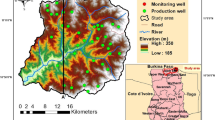Abstract
This study deals with the implications of depletion of groundwater levels in three layered aquifers and its management to optimize the supply demand in the urban settlement near Kahota Industrial Triangle area, located adjacent to the Soan River, Islamabad Pakistan. Initially, a groundwater 3-D steady-state flow model has been developed, calibrated to the known observed heads of 24 water wells, verified, and confirmed that convergence has actually arrived and hydraulic heads are no more changing. Later, the transient simulation was carried out with the constant discharge rates of groundwater by means of pumping wells, storage factor, porosity, and observed drawdown matched with the simulated drawdown that appears to fall in close agreement with a difference of 0.25 m. As such, the developed groundwater model has facilitated to understand, evaluate, and to predict regional trends of groundwater flow regimes and their ultimate utilization at a maximum rate of 4.5 million gallons/day for the growing urban settlement. The calibrated and verified model was then used to simulate the depletion of groundwater level, annual water balance, discharge versus time drawdown, and a temporal behavior of the system over an extended period of pumping. The modeling results indicate that, due to the pumping, the direction of flow has changed: first from groundwater regimes to the Soan River and then it is entirely reversed from the Soan River to the groundwater regimes as the drawdown started to deepen.
Similar content being viewed by others
References
Ahmad, Z., & Khawaja, A. A. (1999). Three-dimension flow and solute transport modeling of the Eolian Aquifer in a uniform flow field of a chemical plant. Pakistan Journal of Hydrocarbon Research, 11, 59–74.
Ahmad, Z., & Serrano, S. (2001). Numerical groundwater flow modeling of the Rechna Doab Aquifer, Punjab, Pakistan. In Proceeding of international groundwater modeling conference (IGWMC). MODFLOW 2001 and other Modeling Odysseys, Colorado School of Mines and Geophysics, Denver, USA, 12–14 September.
Ahmad, Z., Ahmad, I., & Gulraiz, A. (1994). A report on groundwater reserve estimation of the Ahmad Khan well field and its safe utilization for the 4000 TPD Luck Cement plant Pezu, D.I. Khan.
Ahmad, Z., Ashraf, M., & Siddiqui, R. F. (1997a). Groundwater computer modeling of the National Park area in the vicinity of Rawal Lake, Islamabad. Journal of Drainage and water Management, 1, 8–21.
Ahmad, Z., Shaista, M., & Gulraiz, A. (1997b). Evaluation of groundwater potential of Islamabad area using logs data of test holes drilled by OGDC. Pakistan Journal of Hydrocarbon Research, 9, 91–101.
Ashraf, A., & Ahmad, Z. (2008). Regional groundwater flow modeling of upper Chaj Doab, Indus Basin. Geophysical Journal International (GJI), 173, 17–24. doi:10.1111/j.1365-246X.2007.03708.x.
Bender, F. K., & Raza, H. A. (Eds.) (1995). Geology of Pakistan Tutte Druckerei GmbH, Salzweg-passau.
Chiang, W.-H., & Kinzelbach, W. (2001). Processing MODFLOW. A simulation system for modeling groundwater flow and pollution.
Elci, A., Molz, F. J., & Waldrop, W. R. (2001). Implications of observed and simulated ambient flow in monitoring wells. Ground Water, 39(6), 853–862. doi:10.1111/j.1745-6584.2001.tb02473.x.
Ghulam, M., & Ahmad, Z. (2007). Management of groundwater resources in Punjab, Pakistan, using a groundwater flow model. Journal of Environmental Hydrology, 15(31), 1–14.
Holder, A. W., Bedient, P. B., & Dawson, C. N. (2000). FLOTRAN, a 3-D ground water model, with comparison to analytical solutions and other models. Advances in Water Resources, 23, 517–530. doi:10.1016/S0309-1708(99)00040-8.
McDonald, M. G., & Harbaugh, A. W. (1996). A modular three-dimensional finite difference groundwater flow model. USGS open-file report 83–875: Modeling Techniques, Book 6.
Naqvi, M., & Ahmad, Z. (2001). Development and verification of a pumping test analysis software “AQ-Analyzer”. In Proceeding of international groundwater modeling conference (IGWMC). MODFLOW 2001 and other modeling Odysseys, Colorado School of Mines and Geophysics, Denver, USA, 12–14 September.
Pollock, D. W. (1988). Semi-analytical computation of path lines for finite difference models. Ground Water, 6(26), 743–750. doi:10.1111/j.1745-6584.1988.tb00425.x.
Pollock, D. W. (1989). MODPATH (version 1.x)—documentation of computer programs to compute and display pathlines using results from the U. S. Geological Survey modular three-dimensional finite-difference ground-water model. U. S. Geological Survey Open-file report 89–381.
WAPDA, Lower Indus Report (1965). Physical Resources, groundwater, supl.6.1.6, Tubewells and Boreholes.
Waterloo Hydrogeologic Software (2002). Aquifer Test Pro User’s Manual, Graphical analysis and reporting of pumping test and slug test data, (pp. 270).
Wen-Hsing, C., & Wolf, K. (1988). Processing modflow, a simulation system for modeling groundwater flow and pollution.
Williams, V. S., Iqbal Sheikh, M., Pasha, M. K., Ali Khan, K. S., & Reza, Q. (1992). Preliminary report on the environmental geology of the Islamabad–Rawalpindi area, Pakistan. In Proceedings of the first South Asia geological congress Islamabad.
Author information
Authors and Affiliations
Corresponding author
Rights and permissions
About this article
Cite this article
Ahmad, Z., Kausar, R. & Ahmad, I. Implications of depletion of groundwater levels in three layered aquifers and its management to optimize the supply demand in the urban settlement near Kahota Industrial Triangle area, Islamabad, Pakistan. Environ Monit Assess 166, 41–55 (2010). https://doi.org/10.1007/s10661-009-0983-9
Received:
Accepted:
Published:
Issue Date:
DOI: https://doi.org/10.1007/s10661-009-0983-9




